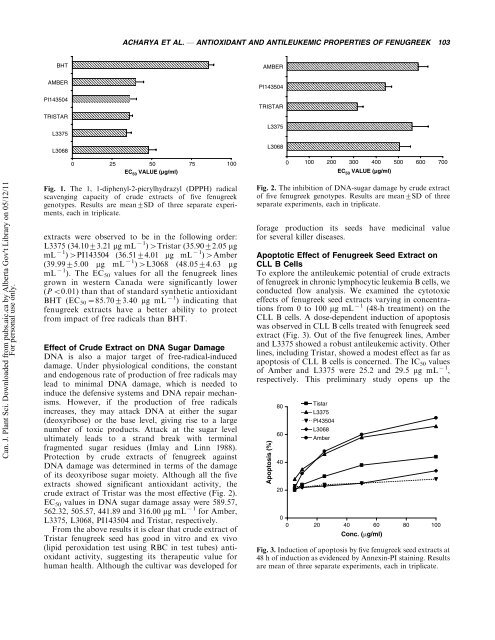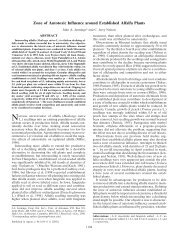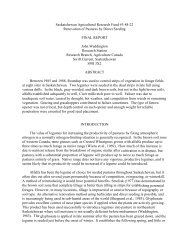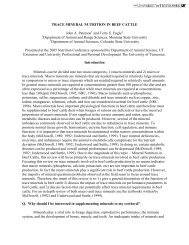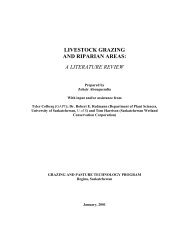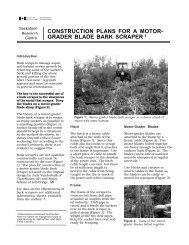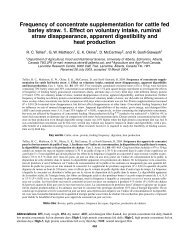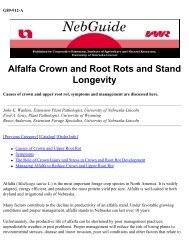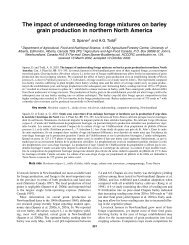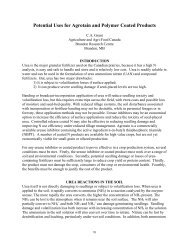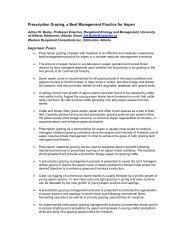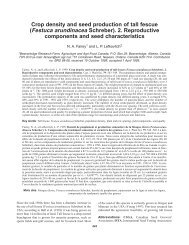Antioxidant and antileukemic properties of selected fenugreek ...
Antioxidant and antileukemic properties of selected fenugreek ...
Antioxidant and antileukemic properties of selected fenugreek ...
You also want an ePaper? Increase the reach of your titles
YUMPU automatically turns print PDFs into web optimized ePapers that Google loves.
Can. J. Plant Sci. Downloaded from pubs.aic.ca by Alberta Gov't Library on 05/12/11<br />
For personal use only.<br />
BHT<br />
AMBER<br />
PI143504<br />
TRISTAR<br />
L3375<br />
L3068<br />
ACHARYA ET AL. * ANTIOXIDANT AND ANTILEUKEMIC PROPERTIES OF FENUGREEK 103<br />
0 25 50<br />
EC50 VALUE (µg/ml)<br />
75 100<br />
Fig. 1. The 1, 1-diphenyl-2-picrylhydrazyl (DPPH) radical<br />
scavenging capacity <strong>of</strong> crude extracts <strong>of</strong> five <strong>fenugreek</strong><br />
genotypes. Results are mean9SD <strong>of</strong> three separate experiments,<br />
each in triplicate.<br />
extracts were observed to be in the following order:<br />
L3375 (34.1093.21 mg mL 1 ) Tristar (35.9092.05 mg<br />
mL 1 ) PI143504 (36.5194.01 mg mL 1 ) Amber<br />
(39.9995.00 mg mL 1 ) L3068 (48.0594.63 mg<br />
mL 1 ). The EC50 values for all the <strong>fenugreek</strong>lines<br />
grown in western Canada were significantly lower<br />
(P B0.01) than that <strong>of</strong> st<strong>and</strong>ard synthetic antioxidant<br />
BHT (EC50 85.7093.40 mg mL 1 ) indicating that<br />
<strong>fenugreek</strong>extracts have a better ability to protect<br />
from impact <strong>of</strong> free radicals than BHT.<br />
Effect <strong>of</strong> Crude Extract on DNA Sugar Damage<br />
DNA is also a major target <strong>of</strong> free-radical-induced<br />
damage. Under physiological conditions, the constant<br />
<strong>and</strong> endogenous rate <strong>of</strong> production <strong>of</strong> free radicals may<br />
lead to minimal DNA damage, which is needed to<br />
induce the defensive systems <strong>and</strong> DNA repair mechanisms.<br />
However, if the production <strong>of</strong> free radicals<br />
increases, they may attackDNA at either the sugar<br />
(deoxyribose) or the base level, giving rise to a large<br />
number <strong>of</strong> toxic products. Attackat the sugar level<br />
ultimately leads to a str<strong>and</strong> breakwith terminal<br />
fragmented sugar residues (Imlay <strong>and</strong> Linn 1988).<br />
Protection by crude extracts <strong>of</strong> <strong>fenugreek</strong>against<br />
DNA damage was determined in terms <strong>of</strong> the damage<br />
<strong>of</strong> its deoxyribose sugar moiety. Although all the five<br />
extracts showed significant antioxidant activity, the<br />
crude extract <strong>of</strong> Tristar was the most effective (Fig. 2).<br />
EC 50 values in DNA sugar damage assay were 589.57,<br />
562.32, 505.57, 441.89 <strong>and</strong> 316.00 mg mL 1 for Amber,<br />
L3375, L3068, PI143504 <strong>and</strong> Tristar, respectively.<br />
From the above results it is clear that crude extract <strong>of</strong><br />
Tristar <strong>fenugreek</strong>seed has good in vitro <strong>and</strong> ex vivo<br />
(lipid peroxidation test using RBC in test tubes) antioxidant<br />
activity, suggesting its therapeutic value for<br />
human health. Although the cultivar was developed for<br />
AMBER<br />
PI143504<br />
TRISTAR<br />
L3375<br />
L3068<br />
0 100 200 300 400 500 600 700<br />
EC 50 VALUE (µg/ml)<br />
Fig. 2. The inhibition <strong>of</strong> DNA-sugar damage by crude extract<br />
<strong>of</strong> five <strong>fenugreek</strong>genotypes. Results are mean9SD <strong>of</strong> three<br />
separate experiments, each in triplicate.<br />
forage production its seeds have medicinal value<br />
for several killer diseases.<br />
Apoptotic Effect <strong>of</strong> Fenugreek Seed Extract on<br />
CLL B Cells<br />
To explore the <strong>antileukemic</strong> potential <strong>of</strong> crude extracts<br />
<strong>of</strong> <strong>fenugreek</strong>in chronic lymphocytic leukemia B cells, we<br />
conducted flow analysis. We examined the cytotoxic<br />
effects <strong>of</strong> <strong>fenugreek</strong>seed extracts varying in concentrations<br />
from 0 to 100 mg mL 1 (48-h treatment) on the<br />
CLL B cells. A dose-dependent induction <strong>of</strong> apoptosis<br />
was observed in CLL B cells treated with <strong>fenugreek</strong>seed<br />
extract (Fig. 3). Out <strong>of</strong> the five <strong>fenugreek</strong>lines, Amber<br />
<strong>and</strong> L3375 showed a robust <strong>antileukemic</strong> activity. Other<br />
lines, including Tristar, showed a modest effect as far as<br />
apoptosis <strong>of</strong> CLL B cells is concerned. The IC50 values<br />
<strong>of</strong> Amber <strong>and</strong> L3375 were 25.2 <strong>and</strong> 29.5 mg mL 1 ,<br />
respectively. This preliminary study opens up the<br />
Apoptosis (%)<br />
80<br />
60<br />
40<br />
20<br />
Tistar<br />
L3375<br />
PI43504<br />
L3068<br />
Amber<br />
0<br />
0 20 40 60 80 100<br />
Conc. (µg/ml)<br />
Fig. 3. Induction <strong>of</strong> apoptosis by five <strong>fenugreek</strong>seed extracts at<br />
48 h <strong>of</strong> induction as evidenced by Annexin-PI staining. Results<br />
are mean <strong>of</strong> three separate experiments, each in triplicate.


